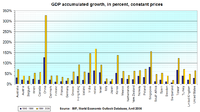
Photo from wikipedia
Selecting an appropriate growth pattern for individual fish is a meaningful but complex topic in fishery research. We model four growth functions − the commonly used von Bertalanffy growth model… Click to show full abstract
Selecting an appropriate growth pattern for individual fish is a meaningful but complex topic in fishery research. We model four growth functions − the commonly used von Bertalanffy growth model (VBGM), and the Gompertz growth model (GGM), Schnute–Richards growth model (SRGM), and generalized VBGM (G-VBGM) − to examine possible growth patterns. Mean total length-at-age fish datasets for five commercial fish species (yellow perch Perca flavescens, walleye Sander vitreus, northern pike Esox lucius, largemouth bass Micropterus salmoides and lake herring Coregonus artedi) from North American freshwater ecosystems, were analyzed. Using a Markov chain Monte Carlo (MCMC) algorithm, we structured four models combining informative priors of model parameters. It is the first time that deviance information criterion (DIC) and leave-one-out cross-validation (LOOCV) were combined to select the best growth model. During the model-selection process, the smooth LOOCV error successfully followed the trend of the LOOCV error, although there were difference in the curve shapes. Values of scale reduction factor (SRF) for all four models indicated convergence, ranging 1.02–1.06, below the 1.2 threshold. The GGM was selected for C. artedi, and the G-VBGM for the other four species. Our approach provided a robust process in model-selection uncertainty analysis, with the G-VBGM having the best prediction ability among our datasets.
Journal Title: Aquatic Living Resources
Year Published: 2020
Link to full text (if available)
Share on Social Media: Sign Up to like & get
recommendations!